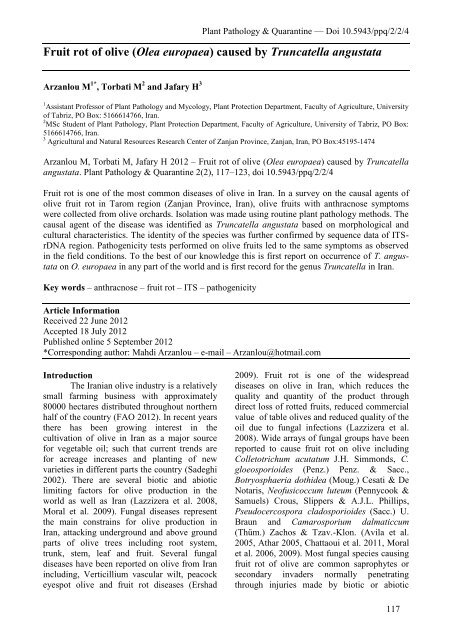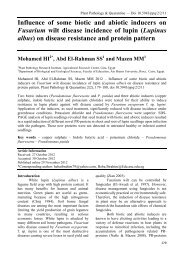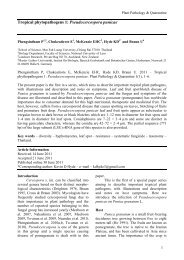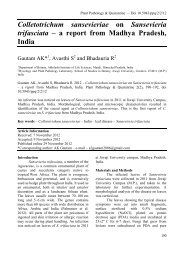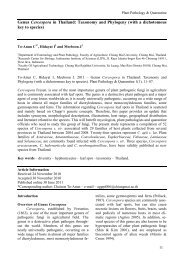View PDF - Plant Pathology & Quarantine
View PDF - Plant Pathology & Quarantine
View PDF - Plant Pathology & Quarantine
Create successful ePaper yourself
Turn your PDF publications into a flip-book with our unique Google optimized e-Paper software.
<strong>Plant</strong> <strong>Pathology</strong> & <strong>Quarantine</strong> — Doi 10.5943/ppq/2/2/4<br />
Fruit rot of olive (Olea europaea) caused by Truncatella angustata<br />
Arzanlou M 1* , Torbati M 2 and Jafary H 3<br />
1<br />
Assistant Professor of <strong>Plant</strong> <strong>Pathology</strong> and Mycology, <strong>Plant</strong> Protection Department, Faculty of Agriculture, University<br />
of Tabriz, PO Box: 5166614766, Iran.<br />
2<br />
MSc Student of <strong>Plant</strong> <strong>Pathology</strong>, <strong>Plant</strong> Protection Department, Faculty of Agriculture, University of Tabriz, PO Box:<br />
5166614766, Iran.<br />
3<br />
Agricultural and Natural Resources Research Center of Zanjan Province, Zanjan, Iran, PO Box:45195-1474<br />
Arzanlou M, Torbati M, Jafary H 2012 – Fruit rot of olive (Olea europaea) caused by Truncatella<br />
angustata. <strong>Plant</strong> <strong>Pathology</strong> & <strong>Quarantine</strong> 2(2), 117–123, doi 10.5943/ppq/2/2/4<br />
Fruit rot is one of the most common diseases of olive in Iran. In a survey on the causal agents of<br />
olive fruit rot in Tarom region (Zanjan Province, Iran), olive fruits with anthracnose symptoms<br />
were collected from olive orchards. Isolation was made using routine plant pathology methods. The<br />
causal agent of the disease was identified as Truncatella angustata based on morphological and<br />
cultural characteristics. The identity of the species was further confirmed by sequence data of ITSrDNA<br />
region. Pathogenicity tests performed on olive fruits led to the same symptoms as observed<br />
in the field conditions. To the best of our knowledge this is first report on occurrence of T. angustata<br />
on O. europaea in any part of the world and is first record for the genus Truncatella in Iran.<br />
Key words – anthracnose – fruit rot – ITS – pathogenicity<br />
Article Information<br />
Received 22 June 2012<br />
Accepted 18 July 2012<br />
Published online 5 September 2012<br />
*Corresponding author: Mahdi Arzanlou – e-mail – Arzanlou@hotmail.com<br />
Introduction<br />
The Iranian olive industry is a relatively<br />
small farming business with approximately<br />
80000 hectares distributed throughout northern<br />
half of the country (FAO 2012). In recent years<br />
there has been growing interest in the<br />
cultivation of olive in Iran as a major source<br />
for vegetable oil; such that current trends are<br />
for acreage increases and planting of new<br />
varieties in different parts the country (Sadeghi<br />
2002). There are several biotic and abiotic<br />
limiting factors for olive production in the<br />
world as well as Iran (Lazzizera et al. 2008,<br />
Moral et al. 2009). Fungal diseases represent<br />
the main constrains for olive production in<br />
Iran, attacking underground and above ground<br />
parts of olive trees including root system,<br />
trunk, stem, leaf and fruit. Several fungal<br />
diseases have been reported on olive from Iran<br />
including, Verticillium vascular wilt, peacock<br />
eyespot olive and fruit rot diseases (Ershad<br />
2009). Fruit rot is one of the widespread<br />
diseases on olive in Iran, which reduces the<br />
quality and quantity of the product through<br />
direct loss of rotted fruits, reduced commercial<br />
value of table olives and reduced quality of the<br />
oil due to fungal infections (Lazzizera et al.<br />
2008). Wide arrays of fungal groups have been<br />
reported to cause fruit rot on olive including<br />
Colletotrichum acutatum J.H. Simmonds, C.<br />
gloeosporioides (Penz.) Penz. & Sacc.,<br />
Botryosphaeria dothidea (Moug.) Cesati & De<br />
Notaris, Neofusicoccum luteum (Pennycook &<br />
Samuels) Crous, Slippers & A.J.L. Phillips,<br />
Pseudocercospora cladosporioides (Sacc.) U.<br />
Braun and Camarosporium dalmaticcum<br />
(Thüm.) Zachos & Tzav.-Klon. (Avila et al.<br />
2005, Athar 2005, Chattaoui et al. 2011, Moral<br />
et al. 2006, 2009). Most fungal species causing<br />
fruit rot of olive are common saprophytes or<br />
secondary invaders normally penetrating<br />
through injuries made by biotic or abiotic<br />
117
118<br />
<strong>Plant</strong> <strong>Pathology</strong> & <strong>Quarantine</strong> — Doi 10.5943/ppq/2/2/4<br />
Figs 1–4 – Truncatella angustata. 1–2 7-day-old colony on PDA (1: above, 2: reverse). 3–4<br />
Conidia with apical appendages. 5 Annellidic conidiogenous cell. – Bars = 10 µm.<br />
factors (Lazzizera et al. 2008). In the present<br />
paper we report occurrence of a new fruit rot<br />
disease on olive in Iran.<br />
Methods<br />
Isolates and morphology<br />
Olive fruits with fruit rot symptoms<br />
were collected from olive orchards in the<br />
Tarom region in Zanjan Province. Isolation<br />
was made from the symptomatic tissues. For<br />
this propose, small pieces approximately 0.5 ×<br />
0.5 × 0.5 cm were cut from the margins of<br />
infected fruit tissues and surface-sterilized for<br />
15–20 sec in 70% ethanol, rinsed with sterile<br />
water three times, dried on sterile filter paper<br />
and transferred to potato dextrose agar (PDA,<br />
Fluka, Hamburg, Germany) plate supplemented<br />
with 100 mg/L streptomycin sulphate and 100<br />
mg/L ampicillin. Single spore cultures were<br />
established from the sporulating fungal<br />
colonies according to the protocol of Bakhshi<br />
et al. (2011). Briefly, under a stereomicroscope,<br />
the tip of a wetted sterile inoculation<br />
needle was touched to conidial mass in an<br />
acervulus and suspended in plates containing<br />
10 ml sterile water (supplemented with<br />
streptomycin sulfate, 100 mg/l). The<br />
suspension was then evenly spread over the<br />
surface of a PDA plate and the plates were kept<br />
in an oblique position overnight. The plates<br />
were then checked under the stereomicroscope<br />
and germinated conidia were transferred to new<br />
PDA plates. Single-spore cultures were<br />
preserved on PDA in 2 ml microtube slants at 4<br />
°C in the Culture Collection of Tabriz<br />
University (CCTU). Morphological characteristics<br />
were examined based on both natural<br />
substrate and single-spore cultures. Cultural<br />
and microscopic features were studied on PDA<br />
culture media (Espinoza et al. 2008). Colony<br />
morphology including colour, shape, and<br />
growth rate was determined after 7 days of<br />
incubation on PDA at 25 °C in darkness.<br />
Microscopic characters were studied using a<br />
smash mount technique with sterile distilled<br />
water as explained by Arzanlou et al. (2007).<br />
Dimension of microscopic structures were<br />
calculated based on 30 measurements for<br />
conidia morphology (shape, colour, and cell<br />
number), size (length and width), and the<br />
presence and size of apical and basal<br />
appendages where possible.
0.05<br />
<strong>Plant</strong> <strong>Pathology</strong> & <strong>Quarantine</strong> — Doi 10.5943/ppq/2/2/4<br />
99<br />
100<br />
85<br />
57<br />
100<br />
CCTU 82<br />
AF405306.1 Truncatella angustata<br />
CCTU 143<br />
CCTU 144<br />
FJ794471.1 Truncatella angustata<br />
GU566260.1 Truncatella angustata<br />
GU934568.1 Truncatella angustata<br />
HM036617.1 Truncatella angustata<br />
HQ288239.1 Pestalotiopsis uvicola<br />
HQ288240.1 Pestalotiopsis uvicola<br />
JN871199.1 Seimatosporium biseptatum<br />
JN871200.1 Seimatosporium eucalypti<br />
DQ491487.1 Xylaria hypoxylon<br />
Fig. 5 – A neighbor-joining phylogenetic trees obtained from the ITS regions and 5.8S rDNA<br />
sequence data. Bootstrap support values from 1000 replicates are indicated on the nodes. The tree<br />
was rooted to Xylaria hypoxylon. The scale bar indicates 0.05 substitutions per site.<br />
Pathogenicity test<br />
Koch's postulates were performed on<br />
surface-sterilized healthy fruits (cultivar Zard).<br />
For this purpose, single-spore cultures were<br />
grown on PDA plates for a week to give<br />
abundant sporulation; a spore suspension with<br />
a final concentration of 10 6 conidia in 1 ml<br />
distilled water was prepared. Fresh olive fruits<br />
were dipped in 70% ethanol for 20–30 sec and<br />
rinsed three times in sterilized water. Fruits<br />
were then dipped in the spore suspension and<br />
placed in sterilized Petri dishes containing<br />
sterilized filter paper (Watman No. 2). The<br />
filter paper was kept wet during the<br />
experiment. For the controls, fruits were dipped<br />
in sterilized distilled water. The experiment<br />
was carried out by using two fungal isolates<br />
and ten replicates (5 Petri dishes, each<br />
containing 2 fruits). Petri dishes were<br />
incubated on the lab bench under daylight<br />
regime, for 6 days until symptoms appeared.<br />
DNA phylogeny<br />
DNA was extracted from 8-day-old<br />
cultures grown on PDA, using the protocol of<br />
Moller et al. (1992). The primer set V9G<br />
(Vilgalys & Hester 1990) and ITS4 (White et<br />
al. 1990) were used to amplify the 3' end of the<br />
18S rRNA gene, ITS1, 5.8S rDNA, ITS2 and<br />
the 5' end of 28S rRNA gene regions. PCR was<br />
performed on a GeneAmp PCR System 9700<br />
(Applied Biosystems, Foster City, CA). The<br />
thermal cycling condition consisted of an initial<br />
denaturation at 95°C for 5 min, followed by 40<br />
cycles of 30 s at 94°C, 30 s at 52°C and 1 min<br />
at 72°C, followed by a final extension cycle at<br />
72°C for 7 min. The reaction mixture contained<br />
1X PCR buffer, 1 mM MgCl2, 60 μl of 1 mM<br />
dNTPs, 0.2 pM of each primer, 0.5 U of Taq<br />
polymerase, 0.5 µl DSMO, and 10–15 ng of<br />
fungal genomic DNA. The final reaction<br />
volume was adjusted to 12.5 μl by adding<br />
sterile distilled water. Amplicons were<br />
sequenced using BigDye Terminator v3.1<br />
(Applied Biosystems, Foster City, CA) Cycle<br />
Sequencing Kit according to the<br />
recommendation of the seller and analyzed on<br />
an ABI Prism 3700 (Applied Biosystems,<br />
Foster City, CA). Raw sequence files were<br />
edited by using SeqManII (DNASTAR,<br />
Madison, Wisconsin, USA) and a consensus<br />
sequence was generated for each of the<br />
sequences. Megablast search option at NCBI’s<br />
GenBank nucleotide database was used to<br />
search for sequence similarity. Sequences with<br />
high similarity were obtained from GenBank<br />
and aligned together with the sequence<br />
obtained in this study. Sequence alignment was<br />
carried out by using ClustalW algorithm<br />
implemented in MEGA 5 (Tamura et al. 2011).<br />
Phylogentic analysis was performed using<br />
Neighbor-joining method (kimura-2 as<br />
119
120<br />
<strong>Plant</strong> <strong>Pathology</strong> & <strong>Quarantine</strong> — Doi 10.5943/ppq/2/2/4<br />
Figs 6–9 – Disease symptoms and pathogenicity test. 6 Symptomatic fruit of olive (cultivar Mary)<br />
naturally infected with T. angustata. 7 Control fruits (cultivar Zard) did not develop any symptoms.<br />
8–9 Symptoms developed on in vitro inoculated olive fruits, 7 days after inoculation.<br />
substitution model; gaps treatment as pairwise<br />
deletion). Transitions and transversions (with<br />
the equal ratio) were included in the analysis.<br />
The bootstrap analysis was performed by<br />
10000 replicates. The phylogenetic tree was<br />
rooted to Xylaria hypoxylon (GenBank<br />
accession number DQ491 478).<br />
Results<br />
Morphological and cultural features<br />
Fungal isolates were identified as<br />
Truncatella angustata (Pers.) S. Hughes based<br />
on morphological examination of pure cultures<br />
in laboratory conditions.<br />
Disease symptoms on olive fruits:<br />
infected fruit had small, water soaked, sunken,<br />
circular spots, which became dark brown or<br />
blackish with age, resembling anthracnose<br />
disease symptoms. Fungal structures were not<br />
observed on naturally infected fruits. In<br />
culture: on PDA colonies were rather fast<br />
growing, attaining 40 mm diam after 7d at<br />
25˚C. Cultures developed dull white to brown,<br />
cottony colonies with black acervuli (about<br />
500-1000 µm diam), mainly in the center of the<br />
PDA plates after 7d. Conidiophores hyaline,<br />
24.5–26 × 2–4.5 µm; conidiogenous cells<br />
annellidic, hyaline, integrated, smooth,<br />
cylindrical; conidia fusiform, straight 18–20 ×<br />
7–8 µm, with 3 transverse septa, median cells<br />
dark brown, 12–14.5 µm long, apical and basal<br />
cells subhyaline; basal appendage absent,<br />
apical appendages variable and often branched,<br />
single or 2–3. Apical appendages were not<br />
observed in some of the conidia (Figs 1–4).<br />
The morphology of our isolates was in full<br />
agreement with the description for Truncatella<br />
angustata (Sutton 1980).<br />
DNA phylogeny<br />
Phylogeny inferred using the sequence<br />
data of ITS region from the isolates obtained in<br />
this study (CCTU 82, 143, 144) with other<br />
known isolates of T. angustata and other<br />
pestalotioid fungi from GenBank clustered our<br />
isolates with T. angustata (100 percent<br />
bootstrap support value) (Fig. 5). One of the<br />
sequences generated in this study was<br />
deposited to GenBank with GenBank<br />
Accession No. JX390614).
Pathogenicity test<br />
Pathogenicity tests performed on<br />
healthy olive fruits led to the same symptoms<br />
as observed in field conditions. Lesions on<br />
fruits became visible within 7d after<br />
inoculation. Water soaked and dark brown<br />
spots appeared on the infected fruits. Controls<br />
did not develop any disease symptom. The<br />
same fungus was recovered from the inoculated<br />
material (Figs 6–9).<br />
Discussion<br />
The causal agent was identified as a<br />
member of the genus Truncatella Steyaert<br />
based on morphological criteria of conidia<br />
including four-cell conidia, straight to slightly<br />
curved, with hyaline apical and basal cells and<br />
two brown to dark brown, thick-walled median<br />
cells. Basal appendages were absent, apical<br />
appendages hyaline, more than one, variable in<br />
size, with dichotomous branches. The<br />
morphological description of Truncatella<br />
isolates from olive fruits was in full agreement<br />
with the description for T. angustata. (Sutton<br />
1980, Espinoza et al. 2008). Phylogenetic<br />
analysis carried out in this study further<br />
confirmed the identity of our isolates as T.<br />
angustata. Olive isolates clustered together<br />
with the other isolates from GenBank with 100<br />
percent bootstrap value.<br />
The results of pathogenicity tests<br />
revealed T. angustata to be pathogenic on olive<br />
fruits. T. angustata has been reported to cause<br />
leaf spot on Leucospermum cordifolium and<br />
dog rose (Taylor et al. 2001, Eken et al 2009),<br />
core rot in apple (Hu et al. 1996), canker and<br />
twig dieback on Vaccinium spp. and grapevine<br />
(Espinoza et al. 2008, Úrbez-Torres et al.<br />
2009), but only the fruit rot phase was<br />
observed in our work. In this study we did not<br />
test pathogenicity of T. angustata on olive trees<br />
to determine if this species is pathogenic on<br />
olive leaves and stems as well.<br />
The genus Truncatella represents a well<br />
known plant pathogen, encompassing some 23<br />
species (Crous et al. 2004). Some of the species<br />
in this genus are endophytic, colonizing plant<br />
tissues without causing visible symptoms,<br />
while others are known pathogens on a wide<br />
array of plants.<br />
The genus Truncatella belongs to<br />
pestalotioid fungi (Lee et al. 2006). In the past,<br />
<strong>Plant</strong> <strong>Pathology</strong> & <strong>Quarantine</strong> — Doi 10.5943/ppq/2/2/4<br />
taxonomy of pestalotioids such as Bartalinia<br />
Tassi, Monochaetia (Sacc.) Allesch., Pestalotia<br />
De Not., Pestalotiopsis Steyaert, Sarcostroma<br />
Cooke, Seimatosporium Corda, Truncatella<br />
have mainly relied on morphological criteria of<br />
conidia (septation, lack or presence/ shape and<br />
branching pattern of appendages,<br />
pigmentation), which have proven to be<br />
troublesome (Jeewon et al. 2002, 2003, 2004,<br />
Kang et al. 1998, 1999, Barber et al. 2011).<br />
The morphological criteria used for the<br />
delineation of pestalotioid fungi are insufficient<br />
and overlap among different genera (Lee et al.<br />
2006, Barber et al. 2011). With the aid of DNA<br />
sequence data, taxonomy of pestalotioid fungi<br />
has undergone drastic revision (Jeewon et al.<br />
2002, 2003, 2004, Kang et al. 1998, 1999, Lee<br />
et al. 2006) and now the boundaries of the<br />
genera are more clear (Lee et al. 2006, Tanaka<br />
et al. 2011).<br />
Very little is known on the biodiversity<br />
of pestalotioid fungi of Iran and there is no<br />
report of Truncatella species from Iran as well<br />
(Ershad 2009). We did not find any report on<br />
the occurrence of a Truncatella on olive<br />
anywhere in the world, and this paper reports<br />
T. angustata as a new pathogen on olive and<br />
first record for the genus Truncatella in Iran.<br />
Acknowledgements<br />
The authors would like to thank the<br />
Research Deputy of the University of Tabriz<br />
and the Studienstiftung Mykologie for financial<br />
support.<br />
References<br />
Arzanlou M, Groenewald JZ, Gams W, Braun<br />
U, Shin HD, Crous PW. 2007 –<br />
Phylogenetic and morphotaxonomic<br />
revision of Ramichloridium and allied<br />
genera. Studies in Mycology 58, 57–93.<br />
Avila A, Groenewald JZ, Trapero A, Crous<br />
PW. 2005 – Characterisation and<br />
epitypification of Pseudocercospora<br />
cladosporioides, the causal organism of<br />
Cercospora leaf spot of olives.<br />
Mycological Research 109, 881–888.<br />
Athar M. 2005 – Infestation of olive fruit fly,<br />
Bactrocera oleae, in California and<br />
taxonomy of its host trees. Agriculturae<br />
Conspectus Scientificus 70, 135–138.<br />
121
Barber PA, Crous PW, Groenewald JZ, Pascoe<br />
IG, Keane P. 2011 – Reassessing<br />
Vermisporium (Amphisphaeriaceae), a<br />
genus of foliar pathogens of eucalypts.<br />
Persoonia 27, 90–118.<br />
Chattaoui M, Rhouma A, Krid S, Triki MA,<br />
Moral J, Massalem M, Trapero A. 2011–<br />
First report of fruit rot of olive caused by<br />
Botryosphaeria dothidea in Tunisia.<br />
<strong>Plant</strong> Disease 95, 770.<br />
Crous PW, Gams W, Stalpers JA, Robert V,<br />
Stegehuis G. 2004 – MycoBank: an<br />
online initiative to launch mycology into<br />
the 21st century. Studies in Mycology 50,<br />
19–22.<br />
Eken C, Spanbayev A, Tulegenova Z, Abiev S.<br />
2009 – First report of Truncatella<br />
angustata causing leaf spot on Rosa<br />
canina in Kazakhstan. Australasian <strong>Plant</strong><br />
Disease Notes 4, 44–45.<br />
Ershad D, 2009 – Fungi of Iran. 3rd edition,<br />
Iranian Research Institution of <strong>Plant</strong><br />
Protection, 531 p.<br />
Espinoza JG, Briceño EX, Keith LM, Latorre<br />
BA. 2008 – Canker and twig dieback of<br />
blueberry caused by Pestalotiopsis spp.<br />
and a Truncatella sp. in Chile. <strong>Plant</strong><br />
Disease 92, 1407–1414.<br />
FAO (Food and Agriculture Organization of<br />
the United Nations). 2012 – FAO<br />
Statistical Databases.<br />
http://www.fao.org/.<br />
Hu LP, Ma CH, Yang GM, Tan WJ. 1996 –<br />
Studies on the causal agent of apple<br />
mouldy core and core rot. Journal of<br />
Fruit Science 13, 157–161.<br />
Jeewon R, Liew ECY, Hyde KD. 2002 –<br />
Phylogenetic relationships of Pestalotiopsis<br />
and allied genera inferred from<br />
ribosomal DNA sequences and morphological<br />
characters. Molecular Phylogenetics<br />
and Evolution 25, 378–392.<br />
Jeewon R, Liew ECY, Simpson JA, Hodgkiss<br />
IJ, Hyde KD. 2003 – Phylogenetic<br />
significance of morphological characters<br />
in the taxonomy of Pestalotiopsis<br />
species. Molecular Phylogenetics and<br />
Evolution 27, 372–383.<br />
Jeewon R, Liew ECY, Hyde KD. 2004 –<br />
Phylogenetic evaluation of species<br />
nomenclature of Pestalotiopsis in relation<br />
to host association. Fungal Diversity 17,<br />
122<br />
<strong>Plant</strong> <strong>Pathology</strong> & <strong>Quarantine</strong> — Doi 10.5943/ppq/2/2/4<br />
39–55.<br />
Kang JC, Kong RYC, Hyde KD. 1998 –<br />
Studies on the Amphisphaeriales. 1.<br />
Amphisphaeriaceae (sensu stricto) and its<br />
phylogenetic relationships inferred from<br />
5.8 S rDNA and ITS2 sequences. Fungal<br />
Diversity 1, 147–157.<br />
Kang JC, Hyde KD, Kong RYC. 1999 –<br />
Studies on Amphisphaeriales: the<br />
Amphisphaeriaceae (sensu stricto).<br />
Mycological Research 103, 53–64.<br />
Lazzizera C, Frisullo S, Alves A, Phillips AJL.<br />
2008 – Morphology, phylogeny and<br />
pathogenicity of Botryosphaeria and<br />
Neofusicoccum species associated with<br />
drupe rot of olives in southern Italy. <strong>Plant</strong><br />
<strong>Pathology</strong> 57, 948–956.<br />
Lee S, Crous PW, Wingfield MJ. 2006 –<br />
Pestalotioid fungi from Restionaceae in<br />
the Cape Floral Kingdom. Studies in<br />
Mycology 55, 175–187.<br />
Moller EM, Bahnweg G, Geiger HH. 1992 – A<br />
simple and efficient protocol for isolation<br />
of high molecular weight DNA from<br />
filamentous fungi, fruit bodies, and<br />
infected plant tissues. Nuclear Acid<br />
Research 20, 6115–6116.<br />
Moral J, De La Rosa R, Leon L, Barranco D,<br />
Michailides TJ, Trapero A. 2006 – High<br />
susceptibility of olive cultivar FS-17 to<br />
Alternaria alternata in Southern Spain.<br />
<strong>Plant</strong> Disease 92, 1252.<br />
Moral J, Oliveira R, Trapero A. 2009 –<br />
Elucidation of the disease cycle of olive<br />
anthracnose caused by Colletotrichum<br />
acutatum. Phytopathology 99, 548–556.<br />
Sadeghi H. 2002 – Olive Production and<br />
Management. The Research, Training<br />
and Extension Organization of<br />
Agriculture, Agricultural Training<br />
Publication, Karaj, Iran, 413 p.<br />
Sutton BC. 1980 – The Coelomycetes. Fungi<br />
imperfecti with pycnidia, acervuli and<br />
stromata. Commonwealth Mycological<br />
Institute, Kew.<br />
Tamura K, Nei M, Kumar S. 2011 – MEGA5:<br />
Molecular Evolutionary Genetics<br />
Analysis using Maximum Likelihood,<br />
Evolutionary Distance, and Maximum<br />
Parsimony Methods. Molecular Biology<br />
and Evolution 28, 2731–2739.<br />
Tanaka K, Endo M, Hirayama K, Okane I,
Hosoya T, Sato T. 2011 – Phylogeny of<br />
Discosia and Seimatosporium, and introduction<br />
of Adisciso and Immersidiscosia<br />
genera nova. Persoonia 26, 85–98.<br />
Taylor JE, Crous PW, Swart L. 2001–<br />
Foliicolous and caulicolous fungi<br />
associated with Proteaceae cultivated in<br />
California. Mycotaxon 78, 75–103.<br />
Urbez-Torres JR, Adams P, Kamas J, Gubler<br />
WD. 2009 – Identification, incidence,<br />
and pathogenicity of fungal species<br />
associated with grapevine dieback in<br />
Texas. American Journal of Enology and<br />
<strong>Plant</strong> <strong>Pathology</strong> & <strong>Quarantine</strong> — Doi 10.5943/ppq/2/2/4<br />
Viticulture 60, 497-507.<br />
Vilgalys R, Hester M. 1990 – Rapid genetic<br />
identification and mapping of<br />
enzymatically amplified ribosomal DNA<br />
from several Cryptococcus species.<br />
Journal of Bacteriology 172, 4238–4246.<br />
White TJ, Bruns TD, Lee SB, Taylor JW. 1990<br />
– Amplification and sequencing of fungal<br />
ribosomal RNA genes for phylogenetics.<br />
In: PCR-Protocols and Applications – A<br />
Laboratory Manual (eds N Innis, D<br />
Gelfand, J Sninsky, TC White).<br />
Academic Press, New York 315–322.<br />
123


